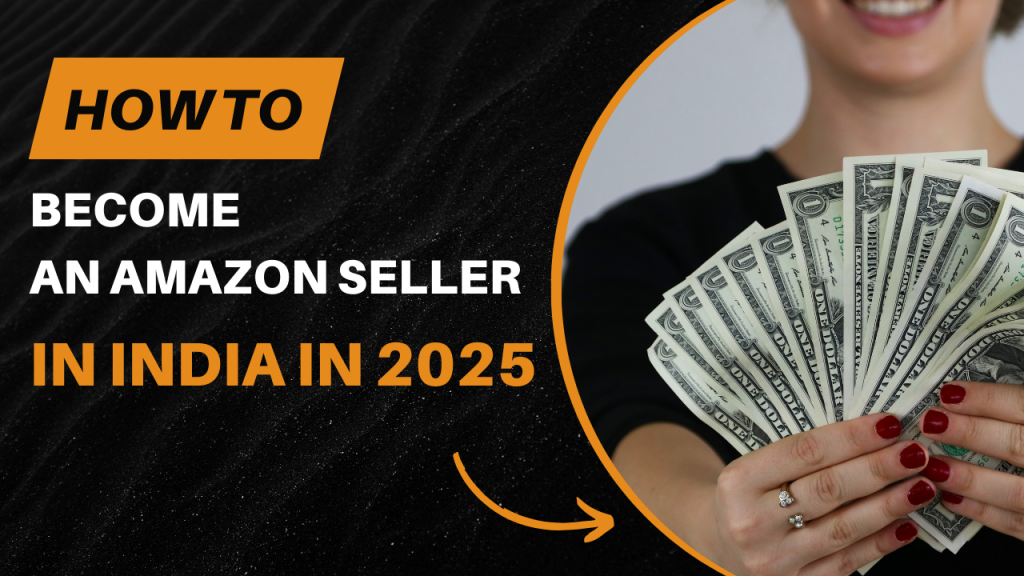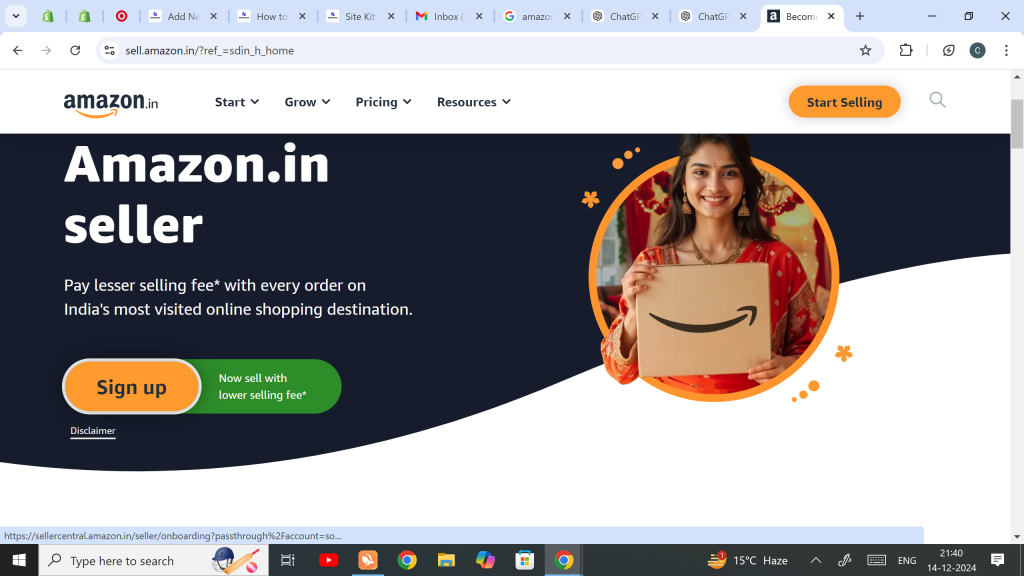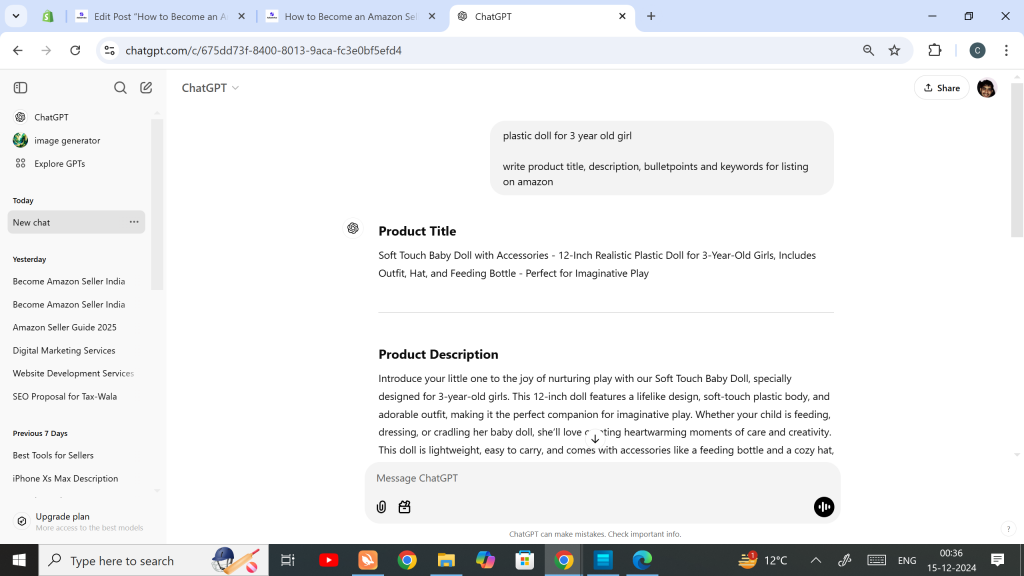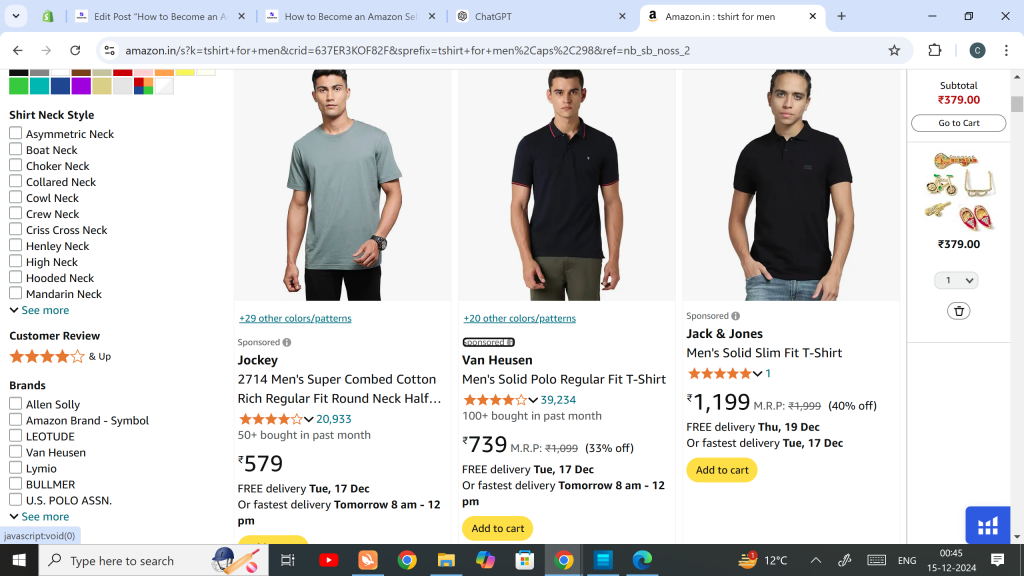
Start your e-commerce journey today! 🌟 Learn how to become a successful Amazon seller in India in 2025. 🚀 # AmazonSeller #EcommerceIndia #StartupTips”
To start selling on Amazon India in 2025, follow these steps:
If you want to become an amazon seller in India and sell products on amazon in 2025 then you must have some mandatory documents to sell on amazon in 2025 and register as seller on amazon with these documents.
Required Documents
- Valid phone number and email ID
- PAN card (Personal or Business)
- GSTIN (Goods and Services Tax Identification Number) (If you don’t have GST Number then you can apply directly on GST portal click here for apply).
- Bank account details (Saving or Current).
- FSSAI License (If you want to sell Food Products then you must have FSSAI License to sell on amazon)
NOTE-
NOTE -You can sell without GST Number also- There are some GST exempted categories on Amazon in which categories you can sell on amazon see full categories list –Click here, if you sell in these categories then you can sell on amazon without GST.
You can create your seller account on amazon with this link- Click for registration

You can start business with amazon in three ways!
1- Fulfilled by Amazon (FBA): This is best method who those want to start online business part time, Side business or Alongwith your job they can do this easily. First register your seller account with amazon FBA then you have to make a shipment to ship . You can stock your inventory in amazon warehouse (FBA) . Once successfully stock inventory in amazon warehouse . You dont need to packs, and ships your products to the customer also returns issue everything will be done by amazon FBA team.
NOTE- For products packing you don’t need to buy packaging material amazon FBA team will arrange it itself but they will take charge for this.
2. Easy Ship: Through Easyship you have to pack your order yourself then you can handover this packed order to the amazon third party courier partner further they will ship your product to the customers. here you have to work for everything like packaging and returns management .
NOTE- For products packing you have to buy Amazon packaging material.
3. Self-Ship: First you have to find your courier partner like shiprocket, DHL, Fedex or another then you have to pack your order yourself then you can handover this packed order to your third party courier partner further they will ship your product to the customers. here you have to work for everything like packaging and returns management .
NOTE- For products packing you have to buy Amazon packaging material.
Product Selection
Begin by deciding which product category you want to sell in. Amazon offers a wide range of categories, including: You can work in single category or in multiple categories.
- Jewelry, Home Décor, and Crafts
- Electronics, Fashion, and Gadgets
- Groceries, Household Items, and Personal Care
- Beauty Products, Toys, and Games
- Clothing, Shoes, Home, and Kitchen
- Books and More
See Popular categories on Amazon in 2025 –Click here
You can start to sell your Own Products or Resell Products:
- Own Products: If you want to sell your own products then you can sell with your brand name for this you must have trademark certificate. If you don’t have trademark then you can apply directly on government site click here.
- Resell Products: if you want resell product then you can buy Product from these suppliers or platforms such as IndiaMART, TradeIndia, ExportersIndia, Manufacturers, Wholesalers, or Distributors -must buy products with GST invoices (Minimum Quantity 10). You can list these products in Generic (Unbranded) on amazon.
Amazon Fees
Amazon takes 3 types of commission to a seller for selling products.
Referral Fee– Its based on product categories its may be vary for each category.
Closing Fee -(based on product price)-Closing Fee is charged every time your product is sold on Amazon based on the price range of the product. This fee also varies based on the fulfillment channel you are using.
Shipping Fees- Its based on received orders like if you received a Local , Regional, National then it take differnt-2 charges on orders.
Read this for detail knowledge about amazon fees – Click here
List Your Products
Once your account is set up, it’s time to add your products:
- Product Listings: Required Product titles, detailed descriptions, Features, Keywords , Min 2 high-quality images ( (Images with White Background), MRP and Selling Prices.
You can take help of chatgtp to writing Product title, Description , feature and keywords like see below!

- Set Competitive Pricing: Use Amazon’s pricing tools (Junglescout, Helium10 and Amzscout) to analyze competitor rates and adjust your prices.
Promote your products to get orders
You can promote your product in amazon seller account (Adverting) through you can show your product on first page on amazon customer page such as below (You can see sponsored word is showing its means they are showing) in the same way you can promote your product on amazon.

Apart from Amazon adverting you can promote your products on Facebook, Instagram and Pinterest through Store page link through this method you can get orders on your amazon seller account.
Order Processing
Once received your first order you can pack and ship your orders to the customers
– If you are doing through easyship method then you have to pack yourself and handover to amazon courier partner.
-If if your doing through amazon FBA then you don’t need to pack your order amazon fba team will pack and ship to the customers itself.
If you are doing through Selfship then you have to pack and ship with help of your own courier partner like DHL, Shiprocket or you can take any.
Payment
Once order delivered to the customers Amazon disburses payments every 14 days to the seller’s bank account. The disbursed amount includes the sales revenue after deducting amazon selling commission like referral fees, closing fees, shipping fees and other.
Order Returns – There are two types of returns one is Courier and Second one is Customers returns .
Courier Returns – When a customer cancels their order before it is dispatched or delivered, Amazon does not charge any fees to the seller for that transaction. This policy ensures that sellers are not financially impacted by order cancellations initiated by customers prior to fulfillment.
Customer Returns -If a customer receives an order, opens it, and subsequently returns it, Amazon charges the seller applicable fees, including reverse pickup fees, closing fees, and referral fees. These charges are deducted to cover the costs associated with processing and managing the return.
Amazon provides an opportunity for sellers to file a SAFE-T claim to address issues related to products damaged by customers or during the return process. This claim mechanism allows sellers to request reimbursement for damaged items, ensuring they are compensated for losses incurred due to circumstances beyond their control.
Challenge for New Sellers On Amazon
Competition–Established Sellers: Competing against seasoned sellers with thousands of reviews, optimized listings, and brand recognition is tough for newcomers.
Building Trust and Credibility–Lack of Reviews: Reviews are crucial for success, but new sellers often struggle to get their first few genuine reviews due to Amazon’s strict policies on review solicitation.
Pricing Wars
- Price Undercutting: Many sellers engage in aggressive price wars to win the Buy Box, often resulting in reduced profit margins.
- High Fees: Amazon’s referral fees, FBA fees, and other costs can make it challenging to maintain profitability, especially for low-margin products.
High Advertising Costs: Amazon’s Pay-Per-Click (PPC) campaigns can be expensive, especially in saturated niches.
Product Differentiation
- Generic Products: Many niches are crowded with similar or identical products, making it hard to stand out.
- Counterfeit Concerns: Sellers may face challenges with copycat or counterfeit products, especially if their brand isn’t registered with Amazon Brand Registry.
Handling Returns: Managing returns and refunds while maintaining profitability is a challenge.
Fees and Policies
- Hidden Costs: Fees like storage fees, long-term storage fees, and promotional costs can eat into profits.
- Policy Changes: Amazon frequently updates its policies, and staying compliant is essential to avoid penalties.
Tips for Overcoming Challenges
- Start with a Niche Product: Avoid saturated categories.
- Use Amazon FBA: Outsource fulfillment to focus on other aspects of your business.
- Invest in Product Listings: High-quality images, detailed descriptions, and keyword optimization are key.
- Run PPC Campaigns Wisely: Set a budget and regularly analyze campaign performance.
- Focus on Customer Service: Prompt responses and great support can help you gain positive reviews.
- Leverage Tools: Use third-party tools for keyword research, inventory management, and analytics.
Q-1- Where to buy products to sell on Amazon India?
Answer- you can buy Product from these suppliers or platforms such as IndiaMART, TradeIndia, ExportersIndia, Manufacturers, Wholesalers, or Distributors -must buy products with GST invoices (Minimum Quantity 10)
Q-2- How to sell on Amazon for free?
Answer- It is not possible to sell completely free of cost on Amazon, as the platform charges certain fees for each sale. However, you can minimize upfront costs by partnering with a supplier willing to provide products on consignment or through a similar arrangement. In this case, you would acquire the product at no initial cost and only pay the supplier after making a sale. Once an order is received, you can then cover the applicable Amazon fees using the proceeds from the sale. This approach allows you to start selling with minimal financial investment.
Q-3-How to sell on Amazon without inventory?
Answer– You can establish a partnership with a supplier, such as those available on platforms like IndiaMART. In this arrangement, the supplier provides their products for you to sell. Once you receive an order, the supplier handles the shipping directly to the customer. This business model, known as dropshipping, enables you to sell products on platforms like Amazon without the need to maintain inventory.
Q-4-How to sell products on amazon from home?
Answer- All the details provided above in the article remain unchanged; you simply need to select the Easyship method for selling from home.
Conclusion
Becoming an Amazon seller in India in 2025 is a straightforward yet rewarding endeavor. By registering on the platform, listing your products effectively, and leveraging Amazon’s vast infrastructure and marketing tools, you can build a successful e-commerce business. With dedication and strategic planning, you can tap into the immense potential of India’s growing online marketplace.
Are you ready to start your Amazon seller journey? Sign up today and turn your business aspirations into reality!


Comments (6)
spunky
February 15, 2025 – 8:23 pmLove your writing style! It reminds me of the creative freedom in Sprunki 1996, where retro gaming meets modern music mixing.
Rene Cooley
March 23, 2025 – 7:51 amPractical advice, always appreciate posts that simplify the process! A free resource on Amazon launch strategies (including sourcing and avoiding common errors) could add value to readers. This may help many people.
Danielle Gates
May 17, 2025 – 4:13 pmFor the reason that the admin of this site is working, no uncertainty very quickly it will be renowned, due to its quality contents.
Jacoby Maynard
May 17, 2025 – 4:34 pmI like the efforts you have put in this, regards for all the great content.
Kylee Norton
May 22, 2025 – 11:07 pmThis is really interesting, You’re a very skilled blogger. I’ve joined your feed and look forward to seeking more of your magnificent post. Also, I’ve shared your site in my social networks!
Hunter Nixon
May 29, 2025 – 5:02 amPretty! This has been a really wonderful post. Many thanks for providing these details.